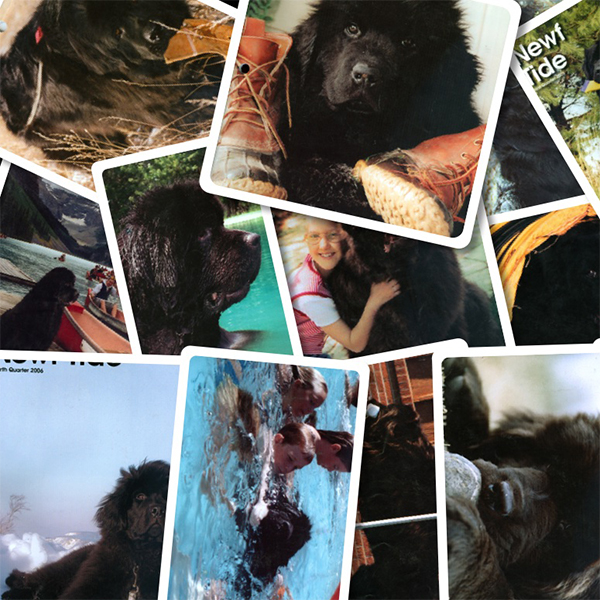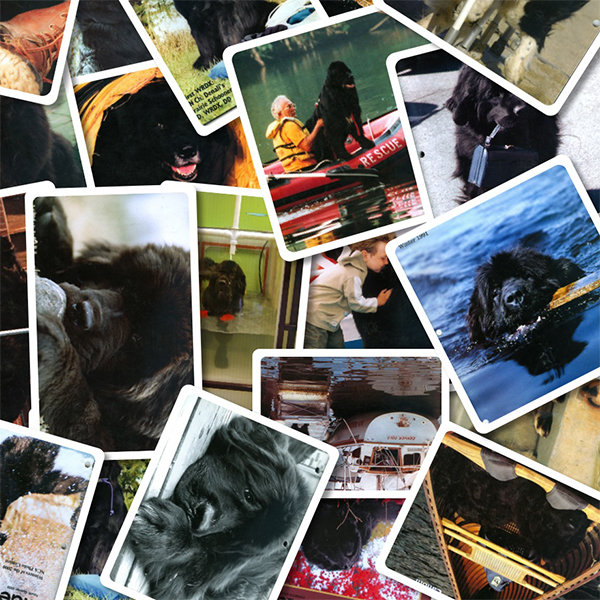by Roger Powell

Newfs love boats, all kinds of boats. Our dogs have ridden in canoes, in rowboats, on pontoon boats, and on ferries and have been instantly at home with all. Given our breed’s background with boats, we Newf owners should not be surprised that our dogs love boats. Now is the best time to be out in a boat with your dog.
For me, Newfs and canoes have always seemed like a natural pairing: the North American dog and the North American boat. Dugout canoes were used widely by early peoples; birch bark canoes were used only by Native Americans. Those canoes lent their design to wood and canvas canoes, and in turn to canoes made of aluminum, kevlar, and other strong materials. Canoes are used in North America more, at least in my impression, than elsewhere. Consie and I prefer wood and canvas canoes because they are beautiful as well as functional. We find that a Newfy lying in a canoe stabilizes the canoe by moving the center of balance deep inside the boat. If the dog’s people kneel, they paddle an incredibly stable craft. If a canoe is not stable with a Newf in it, the instability comes from the dog’s behavior, not from inherent instability of the canoe.
How does one train a Newf to behave in a canoe? Consie and I developed an approach with our first Newfs that turned out also to work perfectly with our daughter, Virginia, when she was very small. Consie generally paddles in the bow and I in the stern. When a puppy starts paddling with us, we put her in front of Consie, way in the bow of the canoe. This placement is good for several reasons. The pup is confined and close to Consie, so Consie can control her and keep her from doing anything dangerous. Consie can also talk to her and teach her what are good things to do in a canoe: keep still, watch, stay to the center. And can teach her what things not to do: don’t bounce, don’t lean over the edge. When Virginia was little, she would stand in the bow of the canoe with her little hands on the bow deck, looking forward. A puppy should not put her paws on the bow deck but she can sit and watch. Being able to see means less fidgeting. When she does move from side to side, her movements have little effect on the balance of the canoe because she cannot move far from the centerline of the canoe. When a puppy gets tired, she can sleep curled on the bottom of the canoe, again in the center. By the time she outgrows the bow of our canoe, a puppy has had many positive experiences being a good puppy in the canoe and will have mastered her basic canoe manners.
A pup needs more training yet to become the canoe dog she can be, but now the training shifts to the person who paddles stern. I like to have an older pup as close in front of me as possible. The pup needs to learn to stay over the centerline of the canoe. When sitting, she can sit on the centerline and look to either side, or around the person paddling bow. When she moves to the side, the stern paddler must lean forward and move her back to the middle (this is easy for a paddler who kneels). When she lies down, she should lie balanced over the centerline. If she shifts to one side or the other, slide her back.
Most Newfies like to lie against a wall, so a pup will commonly lie against the side of the canoe, throwing balance way off. That will not do. She must simply learn to stay in the middle. When a pup has graduated to the large space near the stern paddler, canoe jaunts become training jaunts for a while.
You need to teach your dog how to climb into a canoe. Canoes are meant to float. Sure, you know this, but a canoe that is loaded on land, then slid into the water, is not a happy canoe. As readily as a can opener can open a can, a rock can open the bottom of a canoe. Load your canoe while it floats. Climb into your canoe while it floats. Do not let it touch the bottom. Teach your dog to climb in and out of your canoe while it floats. Once you have trained your Newf to climb into a floating canoe, she can then climb into the canoe from a dock, a rock or a log if necessary. Our dogs often climb into a canoe from a dock. They know the feel of the canoe shifting with their weight. Consie and I steady the canoe as the dog climbs in.
Over nearly 40 years, Consie and I have shared our canoes with some great dogs but perhaps the best boat dog we have ever had is our present eight-year-old, Kaministiquia (pronounce that as it is spelled: ka-min-is-ti-kwa). Her sense of balance in a canoe is uncanny, and she has jumped into and out of canoe from fallen trees and from rocks in smooth to very choppy water. Once she jumped over the bow of our loaded canoe, tripped the light fantastic across Consie’s pack to land in her spot behind the yoke, where she immediately lay down, all hardly jiggling the canoe. She had told Consie and me that she could do it, so we told her to go ahead.
The only Newf we have had who did not immediately take to canoeing was Kwasind. Never has there been a Newf sweeter or gentler than Kwasind but growing up was not easy for him. Each part of him wanted to grow at a different rate, leading him to be, consecutively, high in the rear, low in the rear, cow hocked, roach backed and so on. Ultimately, he evened out but grew so tall that I could not straddle him (31"+). He weighed a lean, play-xylophone-on-his-ribs 190 lbs. He had trouble finding space to lie in a canoe. He would have loved the pontoon boat that Consie and I have now.
And, of course, many people have other boats than canoes. Row boats and motor boats are more common and more stable than canoes. Nonetheless, if you can train your pup with the basics in the confined area in the front of a row boat, you can instill good boat manners early. Teach your puppy not to run around in a boat, no matter how stable the boat, so that when she encounters a boat less stable she will not have developed bad habits.
Kaloosit was extremely concerned the first time she watched me water ski. She was riding in the boat and kept her eyes on me the whole time. When my turn ended and I sunk into the water, she leapt from the boat and swam to me. She came to enjoy water-skiing days. When someone else skied and dropped a ski off shore, she would fetch it. And she loved to swim out to skiers when they finished and swim them to shore.
Although I cringe when I watch a dog loose in the back of a pickup and fear for his eyes when he looks ahead over the cab with the wind blowing his ears, I admit that I do like the way Kaministiquia looks when she stands with her fore-feet on the front seat of our small motor boat, watching to see where we are going. (Our motor is so weak and the boat moves so slowly that Kaministiquia is in no danger.) Kaministiquia is our watch dog, and she keeps track of the world around us.
When we let her outside at our island property, she checks the dock and the lake, she smells the world, and she will lie for hours on the deck keeping track of the world for us. When we use the pontoon boat, she is especially pleased. I think she likes nothing more than the travel across the water from that stable vantage point.
Several times on our travels, Consie and I have taken car ferries. The longest trip was to Newfoundland but the dogs had to stay in the truck on that ferry ride. When we crossed Lake Michigan, however, we learned that Canoni (pronounced chan-O-nee) could be out on the boat if leashed and muzzled. Neither Consie nor I had ever muzzled a dog before but we examined the muzzles available and found one that fit Canoni just fine; it was nicely padded and had lots of space for her muzzle. Canoni took to the muzzle just fine once she learned that she could get puppy biscuits through its mesh. For that ferry ride, Canoni was the poster child for our breed, happy to meet everyone, especially kids. She loved being on the boat and smelling the vast world of Lake Michigan. She had no trouble going up and down the see-through stairs. At the end of the trip, the owners of the ferry business wanted a photo of Canoni on their ferry, happy and interacting with people and wearing the muzzle.
What if you get your puppy during winter? And what about your older dog who simply has never been boating? A full grown Newf can usually fit in the front section of a rowboat or small motor boat and learn her manners. A full-grown Newf will not, however, fit in front of a bow paddler in most canoes. We try to start older dogs in the space right in front of me in the stern, between my knees and the aft thwart. Adult dogs learn quickly to keep balance. Mature dogs, incidentally, are wonderful company and a perfect bow counter-weight for a single person paddling in the stern. The weight of a Newf in
the front half of the canoe prevents the bow from rising out of the water, stabilizes the canoe, and assists steering.
When Consie and I paddle our canoe back to our dock, we hold the dock firmly to stabilize the canoe. The dogs wait till told that they can get out. Then they leap up onto the dock, turn, and immediately give us kisses. We like to think they are thanking us for taking them on a canoe jaunt. We reach up and give them hugs. When you finish a boating jaunt with your Newf, give her a hug from me.
reprinted from NewfTide 2012

